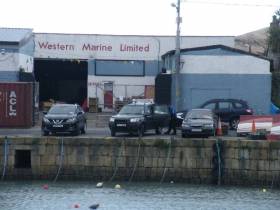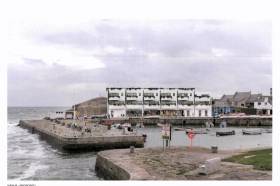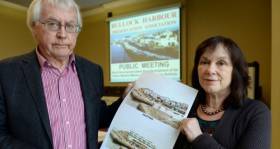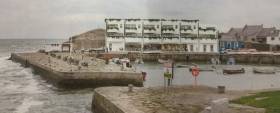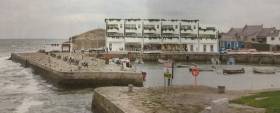Displaying items by tag: Bulloch Harbour, Dalkey
Broadcaster Pat Kenny Vows to Make 'A Good Donation' to Help Fund Fight Against Bulloch Harbour
Broadcaster Pat Kenny has confirmed he'll financially support Dalkey residents in their challenge against a mixed-use development for Bulloch Harbour.
In recent days, householders around Dalkey have received a newsletter asking residents to contribute to a fund-raising initiative.
This is aimed at raising sufficient funds to launch a High Court judicial review of June’s An Bord Pleanála ruling.
Yesterday Dalkey resident Mr Kenny said that he intends to make “a good donation” to the fund-raising effort by the Bulloch Harbour Preservation Association.
“Everyone is being asked to chip in to get the process going,” he said.
“I am no legal expert, but it was a wrong-headed decision made to grant planning permission and it has to be stopped.
For further reading on the development click here
#DublinBay - New plans to redevelop Bulloch Harbour, Dalkey in south Dublin writes The Irish Times has been dismissed by local opponents as “in some respects worse” than an original design rejected by planners a year ago.
A public meeting took place on Tuesday night aimed at rallying opposition to the development (see previous report) which Bartra Capital Property Group is behind.
The company, founded by developer Richard Barrett, has revised its earlier plan and hopes to secure permission from Dún Laoghaire-Rathdown County Council for a scheme that would include two apartments and three large houses. It would also provide a building workshop for “traditional timber boats”, a public square, a cafe, community changing facilities and new units for existing businesses, including boat rentals.
Despite the developer’s insistence it addressed issues arising from its previous application, opponents say they remain concerned about potential flooding, wave over-topping and a scale of build considered “a gross intrusion” to the existing area.
“Unfortunately, this new application is in some respects worse than the one refused by the council,” said the Bulloch Harbour Preservation Association (BHPA) which organised the meeting, attended by about 250 people.
Its members believe the new application “pays virtually no attention to the special character, heritage and history of this small working harbour”.
To read further on the history and heritage of the small south Dublin Bay harbour, click here.
Councillor Urges DLRCC to Turn Down Plans in Bulloch Harbour, Dalkey
#DublinBay - A Councillor has urged Dun Laoghaire Rathdown County Council to reject the latest plans for Bulloch Harbour, Dalkey, writes the Dublin Gazette.
Councillor Michael Merrigan (Ind) has called on council planners to reject the current planning application for a mixed use development on the historic south Dublin Bay harbour pier.
Councillor Merrigan said he had considered in detail the planning application, drawings and reports lodged by the applicant with Dun Laoghaire Rathdown County Council, which Afloat adds took place just days before Christmas.
Afloat also adds that the mixed development lodged to DLCC by Bartra Property is for marine commercial, leisure/community and residential buildings.
A public meeting organised by Save Bulloch Harbour, led by Bulloch Harbour Preservation Association, is to be held next Tuesday, 23 January, for further details see photo-caption above.
As the Dublin Gazette continues, original plans were rejected in February last year after almost 300 residents lodged complaints about the proposal.
Cllr Merrigan said: “The current development proposal submitted to the planning authority is inappropriate for Bulloch Harbour.
“It fails to address, the unique sense of place and maritime heritage and character of the area, which needs to be protected and sensitively enhanced as a coastal amenity.
“As a local county councillor for the area I am disappointed that no progress has been made on a master plan for the harbour.”
Cllr Merrigan said he had a number of concerns over the new plan.
He said that it was an inappropriate development for the area and added that it would have a negative impact on the existing fishing boat hire services.
To read more on the development, click here.
Revised Plan to Be Filed Today for Bulloch Harbour, Dalkey Development
#BullochPlans - Today, new plans are to be filed for a residential and commercial development in picturesque Bulloch Harbour, Dalkey, 10 months after a similar, controversial scheme was refused permission.
As The Irish Times writes, Bartra Capital Ltd, founded by developer Richard Barrett, will submit a revised vision for the small fishing harbour which includes a cafe, “marine leisure” facilities, detached houses and apartments.
The developer says it has taken seven months to consider the views of stakeholders and local residents and believes it has arrived at a “very good scheme”.
However, the Bulloch Harbour Preservation Association (BHPA), which rallied support for a campaign of opposition last January, says despite the new plans having “a nod” toward the community, further opposition is almost certain.
The previously unsuccessful bid prompted public meetings and was ultimately rejected by Dún Laoghaire Rathdown County Council in February.
Although planning will officially be lodged today, a site notice appeared at the harbour yesterday afternoon, outlining the plan.
It has scaled back the residential aspect from nine overall units to five, made up of three detached houses and two apartments.
For more about local concerns, click the newspaper's coverage here.
#BullochPublic - In a move being considered by Dun Laoghaire-Rathdown County Council, the local authority could bring land at Bulloch Harbour in Dalkey into public ownership.
The decision reports DublinLive, would also see the land developed in the public’s interest, was made at this month’s full meeting of the council.
A masterplan for the area cannot be considered by any planning authority unless it is submitted by the owners of the land being considered for development.
As a result, councillors have called on the council to consider taking ownership of the land.
Objections of Nearly 300 to Bulloch Harbour Development Plan
#BullochHarbour - Submissions totalling 283 writes The Irish Times have been filed on a controversial development proposed for one of south Dublin’s most popular coastal inlets.
The Bulloch Harbour planning application would see a mixed-use development of commercial and residential buildings on the seafront.
Hostile public reaction immediately followed its filing in December, with meetings and an opposition campaign as covered on Afloat were quickly organised.
The Dún Laoghaire-Rathdown County Council planning department was still processing objections and observations over the weekend following last Thursday’s deadline.
A decision is expected in March. For more on the story click here.
Locals Encouraged in Dalkey to Object to Bulloch Harbour Plans
#BullochHarbour - Locals in Dalkey opposed to the building of a residential and retail development in Bulloch Harbour writes The Irish Times have been encouraged to lodge planning objections before the January 19th deadline.
More than 100 people attended a meeting in the Royal Marine Hotel in Dún Laoghaire on Saturday regarding the plans. They heard the potential grounds of appeal that campaigners hope will be successful in blocking the proposals.
The proposed development by Bartra Capital Ltd consists of seven ground-floor commercial units fronting onto the harbour itself, with six three-storey terraced dwellings and a further three houses nearby.
Locals have dubbed it a ‘Costa del Sol’ style proposal which they say would significantly impede sea views from the quay and would restrict access to rocks on the foreshore which are currently accessible to the public.
In her presentation, Susan McDonnell of the Bulloch Harbour Preservation Association raised concerns that so-called overtopping from large waves during winter storms (see Afloat coverage photo) could pose a flood risk for new properties.
If this were to happen further down the line, it could cause a risk that homeowners in the entire Bulloch Harbour area would encounter difficulty in getting insurance coverage for flooding, she said.
The newspaper has more by clicking here.
Campaigners Public Meeting To Discuss Proposed Development at Dalkey’s Bulloch Harbour
#BullochHarbour - Concerned residents and marine users of Bulloch Harbour, Dalkey, Co. Dublin are to hold a public meeting tomorrow (Thurs. Jan.5th) over a proposed mixed development at a sensitive coastal site of the former premises of Western Marine, writes Jehan Ashmore.
Afloat last reported just before Christmas of the proposed development by Bartra Property that acquired the site of the chandlery business that are to relocate locally. The site is fronting the quayside of the scenic Dublin Bay harbour. It is one of the last working harbours in the bay with fishing boats, is popular for marine leisure activities and as a tourist attraction in the salubrious southside suburb.
Last month the developer lodged a planning application to seek permission to demolish the single-storey warehouse (1,210 sq m) and replace with the construction of several structures totalling (2,324 sq m) and each of these buildings of three-storeys in height. Click for previous report / image here. According to Save Bulloch Harbour facebook page a public meeting is to be held tomorrow to discuss the development at the Fitzpatrick Hotel, Killiney, Thursday at 7.30pm.
The meeting organisers, Bulloch Harbour Preservation Association whose members include boat users, Dalkey Sea Scouts, Dalkey Community Council and Tidy Towns have raised strong concerns on the proposed redevelopment. The Association claims the proposed development given on grounds of scale, height and bulk will adversely impact and destroy the unique heritage character of the historic harbour that has its origins dating to the 12th century.
Part of the proposed development is a block comprising of two and three stories high containing seven commercial units for marine businesses at ground floor level along the quayside. One of the marine units would be set aside for a café. In addition to six residential apartment units (each of around 1,660 sq ft) at ground floor to the rear and first and second floor overhead. The design of the apartments would feature balconies and roof gardens overlooking the harbour.
In addition at the rear of the former marine chandlery boat storage yard are proposed three houses (each up to 4,800 sq ft). Likewsise of the mixed development block, these dwellings are three-storeys high along with roof terraces. These residential units would exceed the height of the mixed block fronting the harbour built of Dalkey granite. Such cargoes from local quarries were shipped across the bay to assist the Ballast Board in the construction of Dublin Port during the 19th century.
In planning permission documents lodged by Bartra Property to the planning office of Dun Laoghaire-Rathdown County Council, the developers cite in their Planners Report that the brownfield site at Bulloch Harbour, is under the county development Plan 2016-2022. The lands at Bulluch Harbour are zoned with Objective W ‘to provide for waterfront development and harbour related uses’. The developer claims the café along the waterfront will enhance the amenity of the quayside.
Campaign Raises Concerns Over Plans for Three-Storey Development at Dalkey's Bulloch Harbour
#BullochHarbour – Plans to redevelop the former Western Marine site at Bulloch Harbour, Dalkey in south Dublin, with a mixed development of houses, a café and shops are centre stage to a mounting campaign led by local opponents, writes Jehan Ashmore.
Developer Bartra Property Ltd lodged a planning permission with Dun Laoghaire-Rathdown County Council as Afloat reported early this month but further details can be revealed with the depicted image above of the proposed three-storey structure. If granted planning permission this would involve demolition of the existing single-storey warehouse previously used by Western Marine.
The marine business that was based in Dalkey for almost half a century are to relocate to new premises elsewhere but locally within the borough.
The proposed structure at Bulloch Harbour is a mixed use block of two and three stories high containing seven marine based units at ground floor level along the quayside. In addition to six residential units at ground floor to the rear and first and second floor overhead.
According to the Save Bulloch Harbour campaign they have raised concerns on the impact of such a development on the character of the scenic south Dublin Bay harbour. Overlooking the harbour is Bulloch Castle dating to the 12th century having been founded by the Cistercian Monks who held lucrative fishing rights.
A public meeting organised by Save Bulloch Harbour is to held on Thursday 5th January 2017.
The campaign is been led by the newly formed Bulloch Harbour Preservation Association, a group of boat owners, fishermen and harbour users. They claim that the harbour is one of the last small working harbours in county Dublin and the only place to keep or rent a small boat in the south of the county. The stone-cut harbour is notably popular in the summer with locals and tourists availing of marine leisure amenities.
The development in the planning application to DLRCC is described as a mixed-use marine commercial, leisure/community and residential based development, to consult click here.
According to Save Our Seafront (SOS) campaign of Dun Laoghaire Harbour, they claim the Bulloch Harbour development containing the three-storey houses are each about 5,000 square feet.
Further 'Marine' Developments at Dalkey’s Bulloch Harbour
#BullochHarbour – Afloat in October reported of a planning application for a mixed development scheme at the former premises of Western Marine at Dalkey’s Bulloch Harbour, whose waters are under pilotage district of Dublin Port Company, writes Jehan Ashmore.
The developer Bartra Property Ltd has sought planning permission for commercial and residential units located at the scenic south Dublin Bay harbour's waterfront site. It is because of this coastal site that has led to fears by locals and from a newly formed Bulloch Harbour Preservation Group. In addition Dalkey Community Council has since held meetings with the developers, citing concerns that the development will have a big impact on the harbour as a recreational and historical amenity for locals and tourists alike.
Western Marine which has yet to reveal its new home, having for almost half a century occupied the Bulloch Harbour site to where if granted permission the development would require demolition of the existing former chandlery warehouses. The development would involve the construction of six terraced homes over “marine-based activity units” and a quayside café.
It is along this stone-cut quayside hewn of Dalkey granite, is where recent developments to improve the harbour took place throughout the summer, notably the removal of a redundant five tonnes boat-hoist crane, property of Dublin Port Company. The harbour in past times used to have larger vessels trading that saw coal imported by steam-powered colliers.
The improvement works were carried out by the joint efforts of Dublin Port Company, Bulloch Harbour Group and Dalkey Tidy Towns to transform the harbour. Asides the aforementioned removal of the boat-crane coloured in distinctive pale blue, associated works involved upgrading of boat storage areas. Boat users also have new quay wall ladders and use of a refurbished slipway.
Bulloch Harbour is one of the last working harbours in Dublin Bay with its small inshore fishing boats, a large boat-hire fleet popular with anglers during the summer months along with marine leisure users mostly kayakers. The harbour is also home to the 3rd Port / 41st Dublin-Dalkey Sea Scouts which celebrates this year a 60th anniversary.
As to the origins of the quaint harbour where still stands Bulloch Castle built in the 12th century overlooking the present day harbour entrance. The castle towerhouse was established by the Cistercian monks along with lucrative fishing rights. The castle afforded protection for the Monks from that of the marauding Wicklow tribes.
Also as part of the improvement works saw the removal of the rotting boat flower bed and its restoration was completed next to the RNLI flag staff. There is no RNLI station located here but the local lifeboat RNLB Anna Livia from Dun Laoghaire Harbour does make visits to Bulloch for the annual 'Blessing of the Boats" ceremony.
The blessing service sees the 'Trent' class lifeboat berth alongside the harbour’s broad pier where coal was discharged. For a photo and more about ‘Maritime Dalkey’ (a five year long series) published in the September 2013 issue, click the Dalkey Community Council (newsletters) website.
According to the current newsletter, Dalkey Tidy Towns say that the harbour's improvement is a work in progress with more planned in 2017.





























